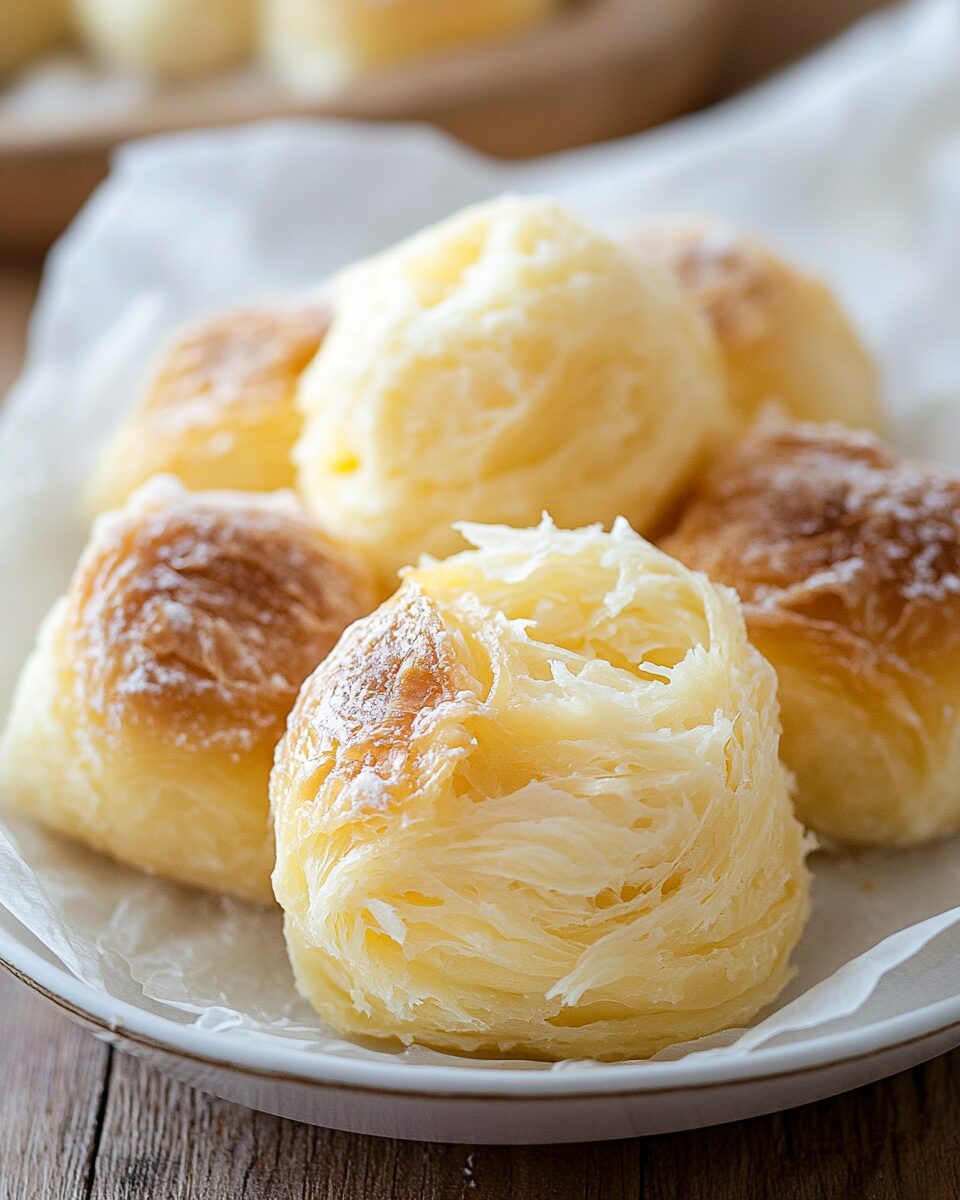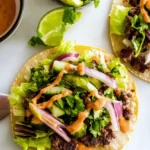Ensaymada is a beloved Filipino sweet bread known for its soft, fluffy texture and rich, buttery taste. This pastry is traditionally topped with butter, sugar, and grated cheese, making it a delightful treat for breakfast or as a snack.
FULL RECIPE:
Ingredients
Ensaymada Dough:
- ½ cup butter, softened
- ¼ cup warm water
- 2 teaspoons active dry yeast
- 1 teaspoon granulated sugar
- 3 ½ cups bread flour
- ⅓ cup sugar
- ¼ tablespoon salt
- 1 cup warm milk
- ½ cup shortening
- 3 egg yolks
Topping:
- ½ cup softened butter
- ½ – 1 cup shredded cheddar cheese
Directions
-
Prepare the Pan
Brush two 30cm round cake pans with softened butter and set aside. -
Activate the Yeast
In a small bowl, combine warm water, yeast, and 1 teaspoon of sugar. Let it sit for 15 minutes until frothy. -
Mix Dry Ingredients
In a large bowl, whisk together bread flour, ⅓ cup sugar, and salt. -
Combine Wet Ingredients
In another bowl, whisk together warm milk, softened butter, and egg yolks. -
Form the Dough
Combine the dry ingredients, wet ingredients, and the activated yeast mixture. Mix until a dough forms. -
Knead the Dough
On a floured surface, knead the dough for about 10 minutes until it becomes smooth and elastic. -
First Rise
Place the dough in a greased bowl, cover with a clean cloth, and let it rise in a warm place for about 1 hour or until doubled in size. -
Shape the Dough
Punch down the risen dough and divide it into 14 equal pieces (approximately 75 grams each). Shape each piece into a ball, then roll into a log about 15 cm long. Coil each log into a spiral shape and place them in the prepared pans. -
Second Rise
Cover the shaped dough with plastic wrap and let them rise for another hour or until doubled in size. -
Bake
Preheat the oven to 350°F (175°C). Bake the ensaymadas for 30 minutes or until golden brown. -
Add Toppings
Once baked, let them cool slightly. Brush the tops with softened butter and sprinkle generously with shredded cheddar cheese.
Nutrition Facts
- Calories: 350 kcal
-
Total Fat: 15g
- Saturated Fat: 6g
- Polyunsaturated Fat: 3g
- Monounsaturated Fat: 6g
- Cholesterol: 71mg
- Sodium: 300mg
-
Total Carbohydrates: 50g
- Dietary Fiber: 2g
- Sugars: 20g
- Protein: 6g
- Vitamin A: 150µg
- Calcium: 60mg
- Iron: 3mg
- Potassium: 200mg
The Rich History of Ensaymada
Ensaymada, a soft and buttery Filipino bread, has a history deeply rooted in the Philippines’ colonial past. This delicacy traces its origins back to the Spanish ensaimada of Mallorca, Spain, which was introduced to the Philippines during the Spanish colonization. The Spanish version was made with lard, flour, water, and sugar, and it had a more rustic, flaky texture. However, over the years, Filipinos adapted and transformed the recipe to suit local palates, replacing lard with butter and incorporating cheese as a key topping. Unlike its Spanish counterpart, the Filipino version of ensaymada is much softer, sweeter, and richer. The addition of butter and sugar on top of the bread gives it an indulgent taste, while the cheese balances the sweetness with a savory note. In the Philippines, ensaymada has become a staple during celebrations and special gatherings, often enjoyed with hot chocolate, coffee, or tea. This beloved pastry has evolved beyond the traditional form, with bakeries and home bakers offering variations that include ube (purple yam), macapuno (coconut sport), and even salted egg toppings.
Ensaymada as a Symbol of Filipino Culture
More than just a pastry, ensaymada represents the Filipino culture of hospitality, warmth, and love for food. It is a common treat shared among families and friends, often given as a gift or pasalubong (souvenir). During Christmas and New Year, ensaymada becomes even more popular, with many families ordering from specialty bakeries to serve it alongside other holiday treats. Many Filipino bakeries, both in the Philippines and abroad, have their own special take on ensaymada. Some are known for their ultra-soft texture, while others focus on the richness of the toppings. Despite these variations, one thing remains the same—ensaymada is a comforting and nostalgic food that brings joy to those who eat it.
Modern Twists on Ensaymada
While the traditional ensaymada remains a favorite, modern bakers have introduced innovative variations to cater to contemporary tastes. One of the most popular versions is the ube ensaymada, which incorporates ube halaya (purple yam jam) into the dough or as a filling. This version adds a vibrant purple color and a unique, mildly sweet flavor that many Filipinos love. Another variation is the chocolate ensaymada, where cocoa powder or chocolate chips are added to the dough, creating a richer, more indulgent treat. Some bakers also offer matcha ensaymada, which includes green tea powder for a slightly bitter contrast to the sweetness of the bread. There are even versions with salted egg crumbles, giving the ensaymada a more complex taste with a combination of salty and sweet flavors. In upscale bakeries and restaurants, ensaymada is sometimes served with gourmet toppings such as truffle-infused butter, imported cheeses, or even gold flakes for a luxurious touch. These modern versions continue to push the boundaries of traditional baking while maintaining the heart of what makes ensaymada special.
Why Ensaymada is a Popular Business Idea
Ensaymada is not just a well-loved pastry it has also become a profitable business for many home bakers and entrepreneurs. The demand for high-quality, handmade ensaymada has grown significantly, both in the Philippines and among overseas Filipinos who long for a taste of home. One of the reasons why ensaymada makes a great business venture is its versatility. It can be made in small batches for home-based sellers or mass-produced for commercial bakeries. With a variety of flavors and toppings to offer, businesses can cater to a wide range of customers with different preferences.
The Science Behind Ensaymada’s Softness
The key to ensaymada’s signature softness lies in the dough preparation and the fermentation process. Using high-protein bread flour ensures a strong gluten network, which helps create a light and airy texture. The presence of butter, egg yolks, and milk in the dough enriches the bread, making it tender and flavorful. The fermentation process also plays a crucial role. Allowing the dough to rise properly enables the yeast to produce carbon dioxide, which results in a well-structured and fluffy bread. Some bakers use a slow fermentation method by refrigerating the dough overnight, which enhances the flavor and creates an even softer texture. Another factor that contributes to ensaymada’s texture is the lamination process. Rolling the dough with butter before shaping it into spirals helps create delicate layers that give the bread a light, flaky bite. When baked correctly, the ensaymada should have a golden brown crust while remaining soft and pillowy inside.
Pairing Ensaymada with Different Beverages
Ensaymada is best enjoyed with a warm beverage, and different pairings can enhance its flavor. In the Philippines, it is traditionally eaten with hot chocolate, known as “tsokolate eh” or “tablea chocolate.” The rich, slightly bitter chocolate balances the sweetness of the ensaymada, creating a comforting and nostalgic combination. For coffee lovers, a strong brewed coffee or espresso pairs well with ensaymada, as the bold flavors of the coffee contrast beautifully with the buttery, cheesy bread. Some people also enjoy it with milk tea or matcha latte for a more modern twist. For those who prefer something cold, an iced caramel macchiato or vanilla frappuccino can be a great pairing, as the caramel and vanilla notes complement the sweetness of the bread. A simple glass of warm milk or soy milk can also be a satisfying and wholesome choice.
Health Considerations and Nutritional Value
While ensaymada is undeniably delicious, it is also a rich and indulgent treat. It is high in carbohydrates, fats, and sugars, making it a food best enjoyed in moderation. However, there are ways to make a healthier version of ensaymada without sacrificing flavor. Using whole wheat flour instead of white bread flour can increase the fiber content of the bread, making it more filling and nutritious. Reducing the amount of sugar and butter in the recipe can also make a lighter version of ensaymada. Some bakers even use plant-based butter and dairy-free cheese for a vegan-friendly alternative. For those watching their calorie intake, portion control is key. Instead of a large ensaymada, opting for a mini-sized version allows for enjoyment without overindulging. Pairing ensaymada with a protein-rich beverage like milk or a protein shake can also help balance the meal and reduce sugar spikes.
Conclusion
Ensaymada is more than just a pastry it is a cherished part of Filipino culture and tradition. From its Spanish roots to its modern-day variations, it has remained a favorite treat for generations. Whether enjoyed with a hot cup of chocolate, served as a holiday staple, or reimagined with new flavors, ensaymada continues to bring joy to those who eat it. Its softness, sweetness, and rich buttery taste make it a comforting and indulgent snack, while its versatility allows bakers to create endless variations. As it continues to evolve, ensaymada remains a symbol of Filipino ingenuity and love for food. Whether you are making it at home, buying it from a local bakery, or starting your own business, this classic treat will always have a special place in Filipino hearts.






